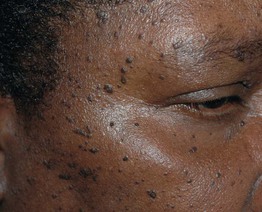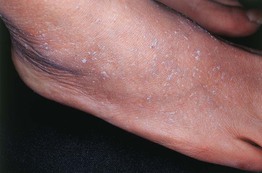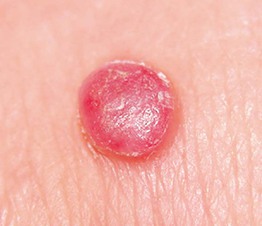89
Benign Epithelial Tumors and Proliferations
Seborrheic Keratosis
• Begin to appear during the 4th decade of life and then gradually increase in number.
• Macular, papular, or verrucous; colors vary from white to black but most commonly brown.
• Typically has a ‘stuck-on’ appearance with a smooth to verrucous surface (Fig. 89.1).
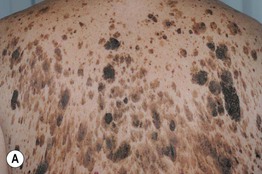
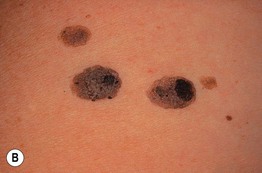
Fig. 89.1 Seborrheic keratoses. A Multiple seborrheic keratoses on the back, with some in a pattern that has been likened to raindrops. B Sharply demarcated pigmented papules and plaques with a papillomatous surface and horn pseudocysts. Note the ‘stuck-on’ appearance. A, Courtesy, Kalman Watsky, MD.
• Spares the palms, soles, and mucosal surfaces.
• Histopathology: a spectrum of different architectures, most commonly acanthotic, papillomatous and hyperkeratotic, or irritated (Fig. 89.2).
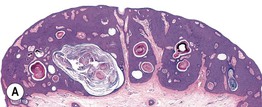

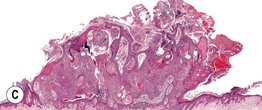
Fig. 89.2 Seborrheic keratoses – spectrum of histologic subtypes. A Acanthotic type with lobular hyperplasia with prominent horn cysts. B Papillomatous or hyperkeratotic type with church spires of papillomatosis and hyperkeratosis. C Irritated seborrheic keratosis. Exophytic lesion with papillomatosis, hyperkeratosis, hemorrhagic crust, and dermal inflammation. A, B, Courtesy, Luis Requena, MD; C, Courtesy, Lorenzo Cerroni, MD.
– Dermatosis papulosa nigra (Fig. 89.3): common in dark-skinned individuals; 1- to 5-mm hyperpigmented papules on the face.
– Stucco keratosis (Fig. 89.4): 1- to 4-mm gray-white papules on the lower extremities (especially dorsal feet and ankles) of older adults.
Clear Cell Acanthoma
Stay updated, free articles. Join our Telegram channel

Full access? Get Clinical Tree


